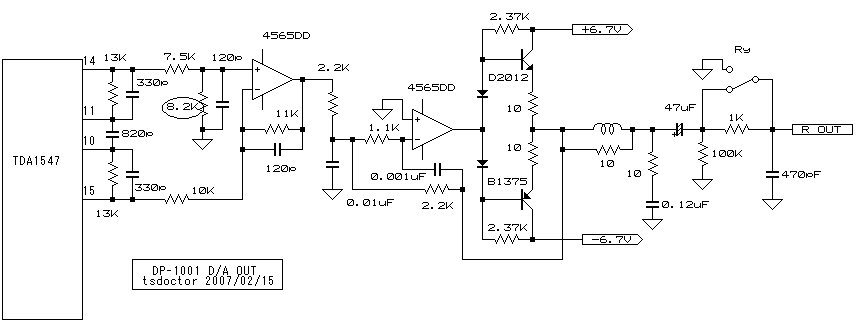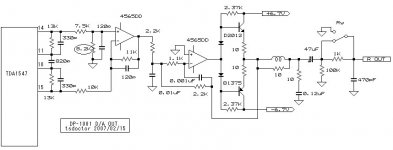But we were talking about anti-aliasing filters and those do work in real-time because they're normally being sent real-world signals from mics and the like.
But the context wasn't listening, it was recording. And yeah recording does need to take place right now or the moment is lost
Well now that the real world is ruining my party I don't know what to say
You could certainly imagine bumping up the sample rate for your initial recording and using causal filters just to get it into an intermediate digital representation, then going back and doing anti-causal post-processing.
For example, if I'm trying to arrive at a 192 kHz / 24 bit recording, start with 1920 kHz / 24 bit recording with the antialiasing filters pushed up to 500 kHz or so. Now that I've got a digital representation of the music, first go back and fix any residual phase contribution from the antialiasing filters and then anti-causally filter the hell out of it.
I mean, c'mon... money's no object, right?
With enough time delay you can have your acausal brick-wall filter. One snag is that brick-wall filters can introduce pre- and post-ringing (perfect brick-wall has ringing for eternity?). People argue about how audible this is, but it certainly frightens people who want to put square waves through a CD system. Better to have slightly gentler filters, and accept that you can't get quite so close to the Nyquist limit?
With enough time delay you can have your acausal brick-wall filter. One snag is that brick-wall filters can introduce pre- and post-ringing (perfect brick-wall has ringing for eternity?). People argue about how audible this is, but it certainly frightens people who want to put square waves through a CD system. Better to have slightly gentler filters, and accept that you can't get quite so close to the Nyquist limit?
Yeah, I've played with this and convinced myself that even my ears hear things they don't like with approximations to super sharp filters. Of course... we can always throw even MORE filters at the problem!
I have talked to SY. I agree with him, there should be no ringing when everything is correct constructed.
And I have read the article from Analog Devices about opamp driving capacitive loads etc.
Analog Devices: Analog Dialogue: Ask The Applications Engineer - 25
Here is the output stage of my CD-Player. I think nothing is wrong constructed.
I have tried to simulate it in Texas Instruments Tina. Input has been a 1 volt step response
but something has been wrong connected, the output voltage has been to low.
I have used the RC4559 instead of the NJM4565.
Does Tina use macro models of the opamps?
Is PSpice better in this case? Sorry, I haven't got Pspice.

And I have read the article from Analog Devices about opamp driving capacitive loads etc.
Analog Devices: Analog Dialogue: Ask The Applications Engineer - 25
Here is the output stage of my CD-Player. I think nothing is wrong constructed.
I have tried to simulate it in Texas Instruments Tina. Input has been a 1 volt step response
but something has been wrong connected, the output voltage has been to low.
I have used the RC4559 instead of the NJM4565.
Does Tina use macro models of the opamps?
Is PSpice better in this case? Sorry, I haven't got Pspice.
Attachments
But the context wasn't listening, it was recording. And yeah recording does need to take place right now or the moment is lost
Since most recordings are monitored by the musicians (thru headphones) the delay needs to stay under 30 ms.( some musicians notice a 10 ms latency!)
Somewhat on topic, for those who are interested, I just put Bruno's feedback article from Linear Audio Vol 1 on-line. It's downloadable from Linear Audio | your tech audio resource under the tab Online resources.
Enjoy!
jan
Enjoy!
jan
@ Jan
Thanks for the article, we already know about that. Bruno says there are no limit for feedback or "too much feedback" is never happen at least in stable region.
Anyway, I still confused with is that make a higher OL with unchanged OLBW will have higher BW (GBW). To get the same BW I have to increase Cc, and this bigger Cc cause a little slowness. This is what makes some misunderstand in myself.
@ChPlus
There is no phase anomalies in non partial delayed line like opamp buffer.
The things happened to active tone controls are just very small phase shift that affect AC transfer characteristics in HF, not phase anomalies.
Free Tina macro model for few opamps, and IC's are usable I like to use UC3844 sim than using real designing.
Thanks for the article, we already know about that. Bruno says there are no limit for feedback or "too much feedback" is never happen at least in stable region.
Anyway, I still confused with is that make a higher OL with unchanged OLBW will have higher BW (GBW). To get the same BW I have to increase Cc, and this bigger Cc cause a little slowness. This is what makes some misunderstand in myself.
@ChPlus
There is no phase anomalies in non partial delayed line like opamp buffer.
The things happened to active tone controls are just very small phase shift that affect AC transfer characteristics in HF, not phase anomalies.
Free Tina macro model for few opamps, and IC's are usable I like to use UC3844 sim than using real designing.
@ Jan
Thanks for the article, we already know about that. Bruno says there are no limit for feedback or "too much feedback" is never happen at least in stable region.[snip]
Well, you can have too much feedback in the sense that you can make the circuit unstable. But I believe Bruno meant that the higher you can make the feedback factor, and still remain stable, the better, objectively, your circuit will perform.
ontoaba;2713312[snip said:Anyway, I still confused with is that make a higher OL with unchanged OLBW will have higher BW (GBW). To get the same BW I have to increase Cc, and this bigger Cc cause a little slowness. This is what makes some misunderstand in myself.
[snip].
Sorry, I don't quite understand what you are saying here.
jan
Does feedback change based on speaker impedance , for eg. when driving 8 ohm nom speakers vs driving a 2 ohm nom speaker .
There will be less negative feedback with a lower output impedance...
It all depends on the open-loop output impedance. If low, then little or no difference. If high, then there will be less loop gain.
Yes. The amount of feedback (the feedback factor) is the difference between the open loop gain and the closed loop gain. If the amp has, for whatever reason, maybe because it has itself a rather high output Z, has less open loop gain with a 2 ohms load, then the difference between open loop gain and closed loop gain is less, so necessarily you have less feedback.
Right Dave
jan
It all depends on the open-loop output impedance. If low, then little or no difference. If high, then there will be less loop gain.
From 8 to 2 ohms loads , it will make a difference , moreover at high frequencies..
There will be less negative feedback with a lower output impedance...
From 8 to 2 ohms loads , it will make a difference , moreover at high frequencies..
I want to agree here wahab , this seems to be what i notice when moving amplifiers around . 1 in particular has an annoying hardness and edge to it's sound on any 8 or 4 ohm nominal system we set it up on , yet on my low imp (1.5 ohm) ribbon hybrid , it is soft sounding with smooth highs and no ringing which was immediately noticed on the other speakers ..
Now the next phase:
When building an amp to drive low impedance speakers should we be using more feedback than recommended for 8 ohm loads ...?
- Status
- This old topic is closed. If you want to reopen this topic, contact a moderator using the "Report Post" button.
- Home
- Amplifiers
- Solid State
- Feedback affects Soundstage, Imaging, Transients ?
